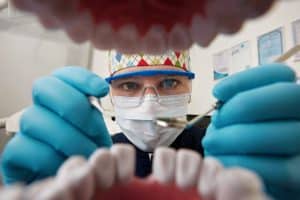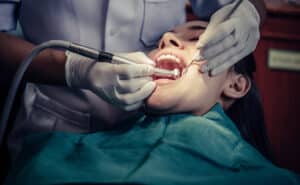A smile has the power to light up a room, but when a tooth is missing, it can dim even the brightest of grins. Fortunately, the field of dentistry has made remarkable strides in tooth replacement, with dental implant innovations emerging as a transformative solution. These modern implants have revolutionized the way we approach tooth restoration, offering a lifelike and durable alternative to bridges and dentures.
Imagine a world where missing teeth are seamlessly replaced, allowing individuals including those seeking a Dentist in Portsmouth, NH, to regain their confidence, eat their favorite foods without worry, and speak with clarity. Dental implants have made this vision a reality. By mimicking the natural structure of teeth, these tiny marvels provide a stable foundation for prosthetic crowns, bridges, or even complete dentures.
Evolution of Dental Implants
From ancient civilizations to medieval times, our ancestors sought ingenious ways to restore smiles marred by missing teeth. Fascinatingly, early attempts at tooth replacement involved everything from animal teeth and seashells to carved ivory and precious metals. While these rudimentary approaches reflected our innate desire to restore dental function and aesthetics, they lacked the durability and compatibility necessary for long-term success.
It was through the perseverance and ingenuity of pioneering minds that modern dental implants were born. Along this evolutionary path, pivotal milestones have marked significant advancements in dental implant technology. In the 1950s, Swedish orthopedic surgeon Dr. Per-Ingvar Brånemark made a groundbreaking discovery—titanium’s unique ability to fuse with bone, a phenomenon he termed “osseointegration.” This revelation laid the foundation for modern dental implants, as Brånemark’s research and subsequent clinical trials demonstrated the tremendous potential of titanium implants for stable tooth replacement.
Since then, numerous innovations have propelled dental implantology to new heights. Advancements in implant design, surface modifications, and surgical techniques have further enhanced the success rates and longevity of dental implants. The development of dental implant systems with various shapes, sizes, and components has enabled personalized treatment plans tailored to each individual’s needs. As a result, implant-supported restorations now offer a level of functionality and aesthetics that closely resemble natural teeth, restoring not only smiles but also self-assurance.
With each new breakthrough, dental professionals and researchers continuously strive to overcome limitations, refine techniques, and push the boundaries of what is possible. This commitment to innovation has transformed dental implants from a mere concept into a reliable and transformative solution for tooth loss. By embracing innovative approaches, the dental community aims to provide patients with the most advanced and effective tooth replacement options available.
Advancements in Implant Design
Osseointegration Enhancements
In the pursuit of improving the integration between dental implants and the jawbone, recent developments in surface modifications and coatings have emerged as game-changers. Researchers and implant manufacturers have been exploring innovative techniques to enhance osseointegration, the process by which the implant fuses with the surrounding bone.
Surface modifications, such as laser etching, sandblasting, and acid etching, create micro-roughened surfaces that promote faster and stronger bone attachment. Additionally, advanced coatings, including bioactive substances and growth factors, have shown promising results in stimulating bone growth and accelerating the osseointegration process. These enhancements not only enhance the long-term stability of dental implants but also contribute to shorter healing times and improved overall implant success rates.
Shorter Implant Treatment
Traditional implant treatment typically involved multiple stages and a prolonged healing period. However, with the advent of immediate load implants and advancements in implant placement techniques, treatment times have significantly decreased.
Immediate load implants, also known as “same-day implants” or “teeth-in-a-day,” allow for the placement of a temporary prosthesis immediately after implant surgery. This approach eliminates the need for a lengthy healing period, allowing patients to leave the dental office with functional teeth on the same day. Furthermore, advancements in implant placement techniques, such as minimally invasive procedures and guided surgery, have streamlined the treatment process and reduced postoperative discomfort. These innovations have transformed the patient experience, making dental implant treatment more convenient, efficient, and time effective.
Computer-Aided Implant Planning
In recent years, computer-aided implant planning has emerged as a transformative technology in dental implantology. Through the integration of advanced imaging technologies, 3D printing, and computer-guided surgery, dental professionals can achieve unprecedented precision and accuracy in implant placement.
Innovative imaging techniques, such as cone-beam computed tomography (CBCT), provide highly detailed 3D images of the patient’s oral structures. These images can be used to create virtual implant treatment plans, allowing dental professionals to meticulously plan implant placement, assess bone density, and identify potential challenges before the actual surgery.
With the aid of 3D printing technology, custom surgical guides can be created, enabling precise transfer of the virtual treatment plan to the patient’s mouth. These surgical guides act as navigational tools during implant surgery, ensuring optimal implant placement according to the predetermined plan. Computer-guided surgery not only enhances the accuracy of implant placement but also minimizes the risk of complications, reduces surgical time, and improves overall treatment outcomes.
Cutting-Edge Technologies in Dental Implant Innovations
Digital Dentistry

Guided Implant Surgery
Guided implant surgery has emerged as a groundbreaking technique that enhances the precision and predictability of implant placement. Through virtual implant planning and the use of surgical guides, dental professionals can navigate complex oral anatomy with unparalleled accuracy. Virtual planning software allows for the meticulous assessment of bone quality, quantity, and anatomical structures. Surgical guides, created based on the virtual plan, act as surgical templates, ensuring optimal implant positioning and angulation during the actual surgery. Guided implant surgery minimizes the margin for error, reduces surgical time, and optimizes functional and aesthetic outcomes.
Regenerative Techniques
The realm of regenerative therapies holds great promise in enhancing implant success and promoting bone regeneration. Platelet-rich fibrin (PRF), derived from the patient’s own blood, contains growth factors and healing properties that stimulate tissue regeneration and improve wound healing. PRF can be utilized during implant surgery to enhance osseointegration and facilitate faster healing.
Another exciting avenue in regenerative techniques is stem cell therapy. Stem cells have the remarkable potential to differentiate into various cell types, including bone-forming cells. This regenerative approach aims to promote bone regeneration and improve the quality and quantity of bone available for implant placement.
These cutting-edge regenerative techniques offer new possibilities for individuals with compromised bone structures, opening doors to implant treatments that were once deemed unfeasible. Ongoing research and advancements in regenerative therapies continue to push the boundaries of dental implantology, offering hope for even more successful and efficient implant procedures.
Consult Us and Experience the Latest in Dental Implant Innovations

Don’t let missing teeth hold you back from smiling confidently. Contact Bay Breeze Dentistry today to schedule a consultation and discover how our expertise in dental implant innovations can transform your smile. Our office is located at 14 Manchester Square, Suite 215 Portsmouth, NH and you can call us at (603) 610-8765 or email us at info@baybreezedentistry.com.










